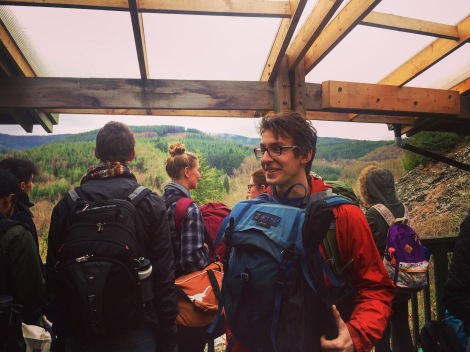
It’s cold in the mornings here. Waking early, I pad through the kitchen and the living room of the house, open the door, and step out into the misty air of the porch. There, bare feet on the wooden deck, I look out at the hillsides and the valleys, the mist coming down the green comb of conifers on the mountain. There’s the quiet roar above from the river turning into reservoir, dropping out onto the micro-hydro turbine. There’s a creak on the slate hill from the vane on the windmill, swinging to meet the air currents. Under its arc, the solar panels sit, gazing up at the clouds.
For four days, we were visiting the Centre for Alternative Technology, hiding out on the Western coast of Wales. Thirty of us in two eco-cabins, off the grid and powered by water, by wind, by sun. We lived for four days, responsible for our energy use, tyring to understand and draw together the threads of our learning about energy, its productions, its systems, its use.


Sitting on top of a windmill blade



Everywhere we go, we see the dark grey slate that made up the quarry out of which CAT sprung, fifty years ago. Slate, this sharp, compacted metamorphic soil, is all around us–as building material, as platter for food, as something we crunch through as we wander in the wooded with Freya, our teaching assistant, learning about where our water comes from, how high you have to reach to catch the wind.Much of CAT’s work is in learning how to build space, and to do so in respecting the source of the materials we have beneath our hands. We stand under the cover of woven willow trees; next to roofs of moss and sedum; lean on walls of pressed earth. When we walk back to the eco-cabins, I see the straw poking out from an old mudded building wall, left to return to the soil. I think of the hay fields we saw on the bus ride here, the sun that would have grown them, the distances they crossed to come here. Material produced here, returning to the earth. Who, seeing this, wouldn’t want to build this way? Houses and buildings that are part of the land, that return to it when they aren’t needed.
This kind of place–a place of learning and teaching, of putting forward what is possible and even what is necessary for us to live in systemic integrity–is at a crossroads, Chris reminds us. Thirty years ago, the Centre for Alternative Technology was the alternative. But now, in the age of global climate deals and ever-expanding renewable production, its innovations have become mainstream.

Roleplaying a council meeting to ‘discuss’ a wind farm proposal.
“So what do you do?” Chris asks us one evening, all assembled. “Do you reach the broadest public, or do you focus on deep education? Do you teach a lot of people just a little, or do you teach a few people a lot?” We think about it and ask it of each other. How do we fit in? We have all come from different places of knowledge, different possibilities for the future–and we’ll be taking these lessons back with us. Are they enough?
Another energy system is possible–we know this now. How do we transition this, then, to the towns and the countries in which we live? And how can we use them to make spaces and communities like the ones we have seen here–not degenrative, not neutral, but generous and regenerative? The answer seems hard to find, but not impossible. Not from what we’ve seen here, and the lessons we’ve been given.
 “My Fitbit says we hiked 152 floors today!” – Richa
“My Fitbit says we hiked 152 floors today!” – Richa


#ECMOnTour #Wales #CAT